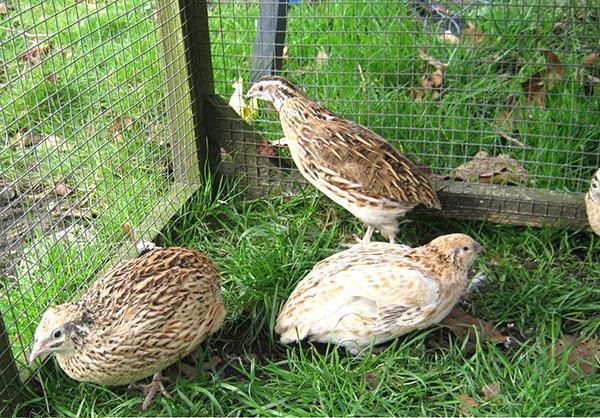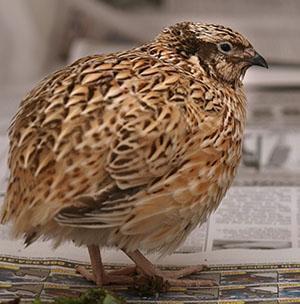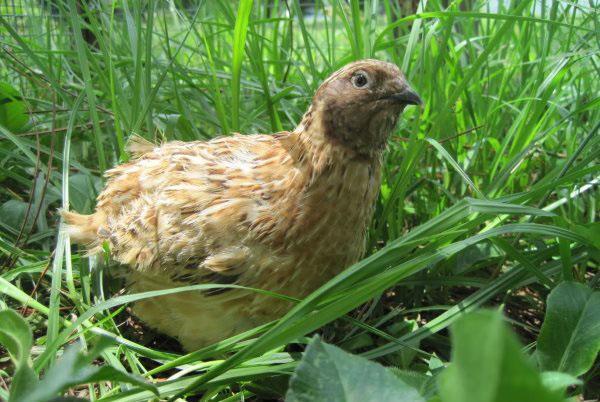Choosing quail breeds for your farm according to a photo with a description
 Wild quails are almost impossible to notice in the grass, not only because of the variegated color that camouflages birds well, but also because of their very modest size. Modern quail breeds and numerous breed lines are larger birds adapted to life in captivity, giving, depending on the orientation, a large amount of dietary eggs and supplying tender meat to the table.
Wild quails are almost impossible to notice in the grass, not only because of the variegated color that camouflages birds well, but also because of their very modest size. Modern quail breeds and numerous breed lines are larger birds adapted to life in captivity, giving, depending on the orientation, a large amount of dietary eggs and supplying tender meat to the table.
Although the wild quail species that are widespread in the world have long been the subject of hunting, the inhabitants of Southeast Asia were the first to show interest in the domestication of birds. Therefore, it is believed that the ancestors of the main quail breeds are the feathered inhabitants of the Japanese islands. Later, in the course of artificial selection and due to the many mutations of rapidly breeding birds, interesting from the point of view of breeding varieties have appeared in other parts of the world.
What are the modern quail breeds and their characteristics? What kind of birds are best raised in your own backyard?
Colorful photos and descriptions of quail breeds, the most popular in the world and among our poultry breeders, will help you understand the huge variety of this poultry and buy birds to your liking and needs.
Japanese quail

Japanese quails are small, variegated-colored birds with an elongated body, short wings that are practically unsuitable for flight and an almost invisible tail.
Like most relatives, males of Japanese quail have a brighter color than females. Their breasts are brown, while those of chickens are light.
The weight of an adult bird reaches 130 grams, and the egg production of a female reaches 300 eggs per calendar year. Having fallen into the hands of breeders, Japanese quails today have become more active and run longer, varieties with greater weight have been obtained. At the same time, the positive features of this breed were maximally preserved: unpretentiousness to conditions of detention and immunity to a number of diseases dangerous for birds.
Manchu golden quail
 The beautiful golden birds outwardly resemble their Japanese counterparts, but their plumage is much lighter and has a distinct yellowish tint. Among poultry farmers in Russia, this breed of quail enjoys well-deserved popularity due to its versatility. The birds are distinguished by both good meat performance and decent egg production. In addition, crossing Manchu meat quails with females of other breeds gives very useful results. The offspring of such unions are distinguished by their large size and rapid weight gain.
The beautiful golden birds outwardly resemble their Japanese counterparts, but their plumage is much lighter and has a distinct yellowish tint. Among poultry farmers in Russia, this breed of quail enjoys well-deserved popularity due to its versatility. The birds are distinguished by both good meat performance and decent egg production. In addition, crossing Manchu meat quails with females of other breeds gives very useful results. The offspring of such unions are distinguished by their large size and rapid weight gain.
For a year, the female of this breed of quail brings up to 220 eggs, very large for this species of bird. The average weight of one piece is 16 grams, while the majority of congeners have an egg weighing from 9 to 12 grams.
Such a weight of eggs is not surprising if you know another characteristic of the quail breed. The female of the Manchu variety can grow up to 300 grams, which is more than twice the mass of the carcass of the Japanese quail.The indicators of males are slightly less, their plump, attractive carcasses for cooks weigh about 200 grams.
 Today, poultry farmers use two different methods of growing the Manchu, golden quail. To obtain large table eggs, the number of layers is kept away from males. Parental families are created only when it is necessary to obtain eggs for incubation.
Today, poultry farmers use two different methods of growing the Manchu, golden quail. To obtain large table eggs, the number of layers is kept away from males. Parental families are created only when it is necessary to obtain eggs for incubation.
Quail pharaoh
 Pharaoh meat quails are the result of the work of American breeders. The appearance of the bird differs little from the natural "wild" color, while the quail is much more massive than the Japanese ancestors. Like their Manchu relatives, these birds perfectly gain weight, which reaches 300 grams in females, and 240 grams in males. The egg production of this quail breed is relatively low. The female brings up to 220 large table eggs per year.
Pharaoh meat quails are the result of the work of American breeders. The appearance of the bird differs little from the natural "wild" color, while the quail is much more massive than the Japanese ancestors. Like their Manchu relatives, these birds perfectly gain weight, which reaches 300 grams in females, and 240 grams in males. The egg production of this quail breed is relatively low. The female brings up to 220 large table eggs per year.
The excellent characteristics of the quail breed, claimed by breeders and American poultry breeders, have been confirmed in Europe and Russia. To date, there are several lines of the Pharaoh breed obtained by poultry farmers from different countries. And American breeders did not stop at their work.
Texas quail
 On the basis of pharaoh quails in Texas, birds of another meat breed were bred, which immediately interested the poultry farmers of the world. These are white Texas quails or white pharaohs, even surpassing their ancestors in weight.
On the basis of pharaoh quails in Texas, birds of another meat breed were bred, which immediately interested the poultry farmers of the world. These are white Texas quails or white pharaohs, even surpassing their ancestors in weight.
The adult female of this species grows to a record 400 grams, while the males are slightly smaller. However, birds can be distinguished not only by fatness and size, but also by their appearance. Texan quails have dense white plumage, sometimes with small single spots, a wide back and chest. An unusual color for the species influenced the color of the bird's skin, so the carcasses of the white Texas pharaoh are more attractive to lovers of gourmet gastronomy than the meat of dark or variegated quails.
Poultry farmers refer to the Texas white quail as unpretentious, fast growing pets, extremely moderate in nutrition.
Estonian quail
 On the basis of the blood of such quail breeds as the pharaoh, the English white Japanese, Estonian quails were obtained. This is an excellent meat-and-meat variety of poultry, which received from its ancestors the ability to maintain egg production, endurance and unpretentiousness for a record long time.
On the basis of the blood of such quail breeds as the pharaoh, the English white Japanese, Estonian quails were obtained. This is an excellent meat-and-meat variety of poultry, which received from its ancestors the ability to maintain egg production, endurance and unpretentiousness for a record long time.
Representatives of this breed of quail have a rounded body, short, like all related birds, wings, a short neck and a convex back. The color of the bird is close to natural. Males are brighter and more expressive than larger females. Telling all about quails from Estonia, one cannot fail to mention their excellent early egg production.
A female that begins to lay at 37–40 days of age can produce up to 30 dozen eggs a year, weighing 9–12 grams each. The birds themselves weigh less than meat congeners. The average weight of a carcass is 120–130 grams, but with such a low weight, the meat is very tasty.
English black quail
 A population of fairly dark birds with brown and sometimes almost black plumage was obtained from Japanese quails in the UK. The breed was named English black quail and quickly spread throughout European countries, including Russia. Compared to their ancestors, this breed of quail is more well-fed, but lags behind in growth rate and does not rush so willingly.
A population of fairly dark birds with brown and sometimes almost black plumage was obtained from Japanese quails in the UK. The breed was named English black quail and quickly spread throughout European countries, including Russia. Compared to their ancestors, this breed of quail is more well-fed, but lags behind in growth rate and does not rush so willingly.
Females of English black quails grow up to 200 grams of live weight, males have an average weight of about 170 grams. Each year, the hen produces 260-280 small gourmet eggs. Due to their unpretentiousness and stable egg production, birds are popular with amateur poultry breeders.
English white quail
 The second British quail breed is outwardly strikingly different from the black-brown counterparts. White English quails belong to the egg variety, but when they find themselves in the kitchen, their carcasses look better than dark ones, which increases the interest of lovers in this poultry.
The second British quail breed is outwardly strikingly different from the black-brown counterparts. White English quails belong to the egg variety, but when they find themselves in the kitchen, their carcasses look better than dark ones, which increases the interest of lovers in this poultry.
Quails have predominantly white plumage, although spots of brown, black or golden hue are acceptable. Starting to lay at the age of 40–45 days, quails produce 280 eggs during the calendar year. The live weight of female English white quail is 160-180 grams, and males grow up to 160 grams.
Tuxedo quail
 The original appearance of tuxedo quails attracts many interested views of poultry breeders to this breed. The variety obtained by crossing white and black English birds has an egg orientation, but also represents meat value for private farms.
The original appearance of tuxedo quails attracts many interested views of poultry breeders to this breed. The variety obtained by crossing white and black English birds has an egg orientation, but also represents meat value for private farms.
The unusual, dark on top and white on the bottom, the color of the representatives of the breed is due to the propensity of quails to mutations, thanks to which breeders have recently obtained not only tuxedo quails, but also birds with beautiful "marble plumage". In such quails on a white background, a bluish-gray reflection on the feathers is clearly visible. It is not uncommon in the backyards of pizzas of golden, blue, fawn colors. The average female tuxedo quail weighs no more than 160 grams, and the cockerels are even smaller. But this does not prevent an interesting bird from bringing up to 280 eggs per year.
Chinese painted quail
 In addition to Japanese quails, painted Chinese birds with a red belly and rich tints of colors on the neck and back are widely known in the world today. Unlike Japanese quails, which are polygamous, this bird prefers to spend its entire life with its only chosen one. Quails are unpretentious and easily adapt to different conditions of detention, jealous of their own housing and its protection.
In addition to Japanese quails, painted Chinese birds with a red belly and rich tints of colors on the neck and back are widely known in the world today. Unlike Japanese quails, which are polygamous, this bird prefers to spend its entire life with its only chosen one. Quails are unpretentious and easily adapt to different conditions of detention, jealous of their own housing and its protection.
Since these quails are quite small, in Asia and Europe today breeding work is underway to breed breeds with the best meat and egg characteristics.
Virgin quail
 Having achieved significant results in the domestication of common quails, poultry farmers are making successful attempts to grow birds that were previously considered exotic in private backyards. An example is the native American species - the Virginia quail. It is distinguished from the usual breeds by an elongated body, large eyes and a shortened beak. The birds have a reddish brown color with bright black and white markings on the feathers. White stripes are clearly visible on the heads of males.
Having achieved significant results in the domestication of common quails, poultry farmers are making successful attempts to grow birds that were previously considered exotic in private backyards. An example is the native American species - the Virginia quail. It is distinguished from the usual breeds by an elongated body, large eyes and a shortened beak. The birds have a reddish brown color with bright black and white markings on the feathers. White stripes are clearly visible on the heads of males.
These quails are larger than usual, but it is too early to talk about their meat orientation and the consolidation of breed characteristics, although after good feeding they have a certain culinary value. Egg production is also not great. But fans of decorative birds will appreciate the golden and snowy Virginia quails.
California quail
 The most unusual and beautiful of the quail is the Californian variety. The head of this breed of quail is crowned with a miniature sultan of several dark feathers. The body of large, up to 25 cm long, birds is round, dense, the tail, although longer than that of other relatives, is still short. Quails have a convex chest, decorated with whitish or yellow feathers with a black border, white contrasting stripes on the forehead and cheeks. Olive back and variegated neck. Females are not as bright as males, but noticeably brighter than many domesticated counterparts.
The most unusual and beautiful of the quail is the Californian variety. The head of this breed of quail is crowned with a miniature sultan of several dark feathers. The body of large, up to 25 cm long, birds is round, dense, the tail, although longer than that of other relatives, is still short. Quails have a convex chest, decorated with whitish or yellow feathers with a black border, white contrasting stripes on the forehead and cheeks. Olive back and variegated neck. Females are not as bright as males, but noticeably brighter than many domesticated counterparts.
Birds are already being bred and raised for meat, as well as for decorating garden-pack areas. Birds are monogamous and early maturing. Californian quail chicks can begin adulthood as early as 35 days of age.